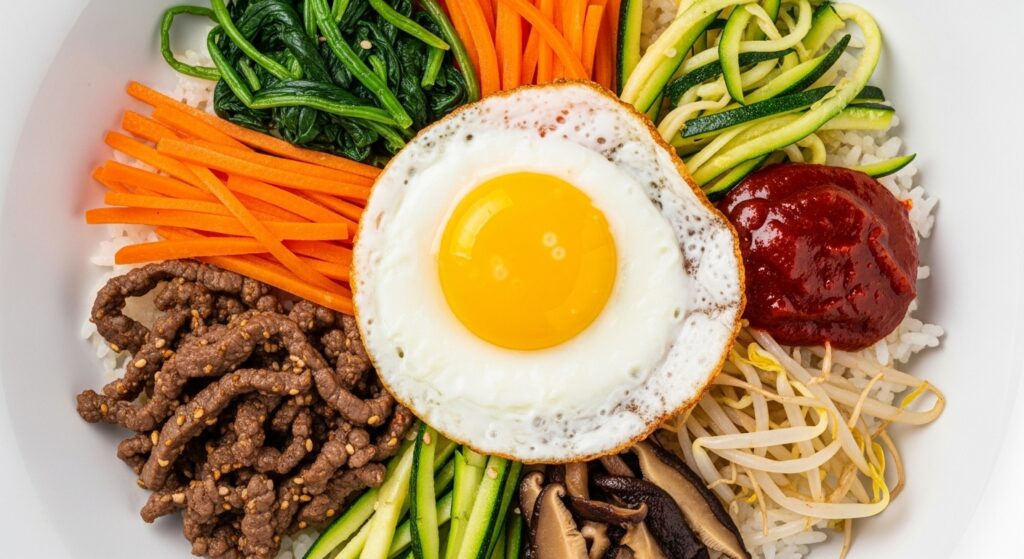The Soul of Simplicity

There’s a quiet poetry in the way Koreans treat leftovers. A bowl of rice from yesterday and kimchi aged beyond its prime somehow meet again in a pan, transforming into something warm, soulful, and deeply human.
Kimchi Fried Rice, or Bokkeumbap, isn’t the kind of dish that demands attention; it’s the kind that finds you when life feels heavy, when the noise of the world softens and you crave something honest. It’s not about complexity — it’s about care, and about the small tenderness that comes from making something with what little you have. It reminds us that warmth doesn’t need to be extravagant; sometimes, it’s found in a humble kitchen filled with the scent of sizzling kimchi.
A Dish Born from Resilience

In every culture, there are dishes that carry the memory of survival — and in Korea, Kimchi Fried Rice quietly holds that legacy. It wasn’t created for celebration, but out of necessity, in kitchens where creativity met limitation.
What began as a way to use what remained became a philosophy of its own — one that honors patience, resourcefulness, and endurance. Fermented kimchi, preserved through time, and rice, the foundation of Korean life, meet not by accident but by intention. Together, they represent a story of making beauty out of scarcity, of finding comfort even in the humblest of meals.
More Than Just Fried Rice

There’s a rhythm to making it — the soft scrape of the spatula, the dance of oil and rice, the sound of kimchi sizzling like quiet applause. For many, this rhythm becomes a ritual, a way to restore order after a long day, a practice of small mindfulness.
It’s not a dish you measure with spoons but one you make by instinct — the same way memory works. Every Korean has their own version, inherited not through recipes but through scent, motion, and rhythm. In that movement lies a familiar peace — a reminder that comfort often hides in repetition.
The Language of Flavor
To outsiders, it might just taste spicy and savory, but for Koreans, its flavor holds something deeper — the language of time and tenderness. The sour edge of kimchi tells of seasons passed; the sesame oil speaks softly of patience and rest; the golden egg on top becomes a gesture of grace.
It’s a dish that speaks to the senses the way old letters speak to memory — ordinary, yet unforgettable. Every bite carries echoes of family tables, late-night conversations, and laughter that lingers long after the meal is gone. That’s why Kimchi Bokkeumbap is never just food — it’s a memory that lives on the tongue.
Why It’s the Korean Soul Food

To call Kimchi Fried Rice a soul food is to admit that comfort can be born from imperfection. It reflects the Korean spirit — resilient, adaptive, endlessly creative in the face of scarcity. It follows people wherever they go, recreated in small kitchens across the world, connecting them to the place they once called home.
Each time the pan sizzles, it carries the same heartbeat: of survival, gratitude, and belonging. It’s not a dish that tries to impress; it’s one that understands. And perhaps that’s what makes it the truest kind of soul food — not fancy, not flawless, but profoundly human.
And if you’re craving something to complete that warmth, try Doenjang-jjigae (Korean Soybean Paste Stew). Its deep, earthy aroma and humble comfort make it the perfect companion to a bowl of Kimchi Fried Rice.
For a perfect side to pair with Kimchi Fried Rice, try my Gyeran-mari (Korean Rolled Omelette) — soft, savory, and made for lunchbox comfort.

Kimchi Fried Rice (Korean Spicy Fried Rice)
Equipment
- 1 Frying pan preferably non-stick
- 1 Spatula for stir-frying
- 1 bowl for serving
Ingredients
- 1 cup cooked rice preferably day-old rice
- 1/2 cup chopped kimchi aged kimchi gives better flavor
- 1 tbsp kimchi juice optional but adds richness
- 1 tbsp gochujang (Korean chili paste) adjust to spice level
- 1 tsp sugar balances acidity
- 1 tbsp sesame oil for aroma
- 1 tbsp vegetable oil for frying
- 1 pc egg fried on top (optional)
- 1 tbsp chopped green onion garnish
- 1 tsp roasted sesame seeds garnish
Instructions
- Heat vegetable oil in a frying pan over medium heat.
- Add chopped kimchi and stir-fry for 2–3 minutes until fragrant.
- Add gochujang, kimchi juice, and sugar. Stir well to combine.
- Add the cooked rice and break up any clumps. Mix evenly with kimchi and sauce.
- Drizzle sesame oil and stir-fry for another 2–3 minutes until rice turns slightly crispy.
- Serve in a bowl and top with a fried egg. Garnish with green onion and sesame seeds.


